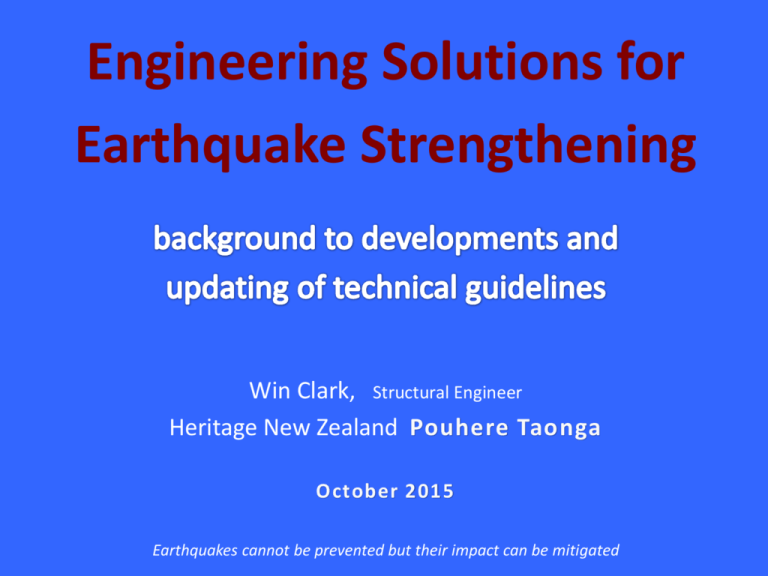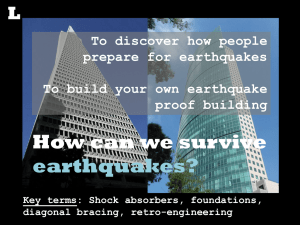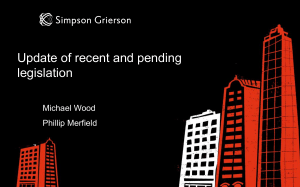Win Clark 2015 HNZ Presentation
advertisement

Engineering Solutions for Earthquake Strengthening Win Clark, Structural Engineer Heritage New Zealand Pouhere Taonga October 2015 Earthquakes cannot be prevented but their impact can be mitigated Topics to be covered: • What is an Earthquake-prone Building ? • Current Proposals in the Building Amendment Bill: Building (Earthquake-prone Buildings) Amendment Bill • Current status of NZSEE Guidelines Review: Assessment and Improvement of the Structural Performance of Buildings in Earthquakes • Structural Assessment and Strengthening: Engineering Objectives. • Developing techniques for Structural Strengthening and Securing. • 7 simple steps to consider when strengthening a building. Earthquake-prone Buildings what are they ? Definition of Earthquake-prone Buildings in the Building Act Section 122 of the Building Act 2004: 1.(a) ultimate capacity exceeded in a moderate earthquake. 1.(b) likely to collapse causing: - Injury or death - damage to any other property 2. Does not apply to a building used for residential purposes, unless: - comprises 2 or more storeys, and - contains 3 or more household units Definition of a “Moderate Earthquake” an earthquake that would generate shaking at the building site that is of the same duration as, but is onethird as strong as the earthquake shaking that would be used to design a new building at that site. Therefore: an earthquake-prone building will have strength that is 33% or less of the seismic loading that meets the standard NZS 1170 Part 5: 2004 for the particular building site. Earthquake Prone Buildings What are the likely scenarios ? •Is a probability of 51% “likely” ? or is a lesser percentage still “likely” ? •Prior to the earthquake, the tectonic mechanism that generated the 22nd February event had a 16% contribution to the seismicity of the Christchurch area. •Peak shaking on the 22nd February lasted for just over second. 4- •Peak Ground Acceleration (PGA) horizontally and vertically was in the order of 2 x gravity (2g). •This acceleration was significantly greater than the Building Code 500-year mean return period design event. Earthquake Prone Buildings • What would be the effect of a longer duration event, but lower PGA ? Similar to what is expected in an Alpine Fault rupture What do we mean by “collapse” ? • The whole building, or parts of the building ? • Can we calculate the collapse load for any existing building ? Colombo Street, Sydenham Canterbury Earthquake 22nd February 2011 Deaths due to Masonry Building Failure On 22nd February the official toll due to the earthquake was 185 From A Risk Framework for Earthquake Prone Building Policy by Tony Taig for DBH July 2012 Territorial Authorities Earthquake-prone Building Policy • Active or Passive Approach to identifying Earthquake-prone Buildings. • Initial Seismic Assessment (ISA) this is a broad screening process to identify potentially Earthquake-prone Buildings. Includes an IEP (Initial Evaluation Procedure). • Territorial Authorities (TAs) notify building owners. • Building owners to engage an experienced engineer to carryout a Detailed Seismic Assessment (DSA) • The DSA will determine the %NBS (New Building Standard) • If %NBS is less than 33% the TA will issue the building owner with a notice to fix in an agreed time frame (Section 124 of BA) Seismic Assessment Continuum Complex structural analysis Simple structural analysis Access to drawings COST Exterior inspection only SEISMIC ASSESSMENT RELIABILITY/ CONFIDENCE Level of judgement required ISA DSA Proposed changes to the Building Act The proposed changes are set out in the: “Building (Earthquake-prone Buildings) Amendment Bill” Bill No. 182-2, Select Committee Report 2/09/15 The most significant changes include: • Definition of “Earthquake-prone”: - includes buildings that pose a risk to adjoining properties. - includes hostels, boarding houses and residential houses more than 2-storeys and contain more than 3-units. - excludes residential houses (except as above), farm buildings, retaining walls, wharves, tunnels and monuments. •Regulations to define the term “ultimate capacity” when used to describe an earthquake-prone building. The most significant changes to the Building Act include: • Seismic Risk - earthquake-prone building identification and remediation process to be based on seismic risk. - The seismic risk of an area would be defined by its hazard factor (Z factor from NZS 1170.5 Loadings Standard) as follows: + High Seismic Risk area - Z factor greater than or equal to 0.3 + Medium Seismic Risk area - Z factor between 0.15 and 0.3 + Low Seismic Risk area - Z factor less than 0.15 - Timeframe for action on earthquake-prone buildings is to vary depending on level of seismic risk. The most significant changes to the Building Act include: • Priority Buildings are defined as buildings that: - are generally used for health or emergency services or as education facilities - contain unreinforced masonry that could fall on to busy thoroughfares in an earthquake (parapets) - the Territorial Authority has identified as having the potential to impede strategic transport routes after an earthquake • Priority Buildings have shorter timeframes for action. The most significant changes to the Building Act include: • Time Frame for identifying Earthquake-prone buildings: - High Seismic Risk Areas: + High Priority buildings – 2.5 years + All other buildings – 5 years - Medium Seismic Risk Areas: + High Priority buildings – 5 years + All other buildings – 10 years - Low Seismic Risk Areas: + All buildings – 15 years •Following identification of a potentially earthquake-prone building, the owner is required to provide and engineering assessment of the building within 12 months. The most significant changes to the Building Act include: • Time Frame for strengthening Earthquake-prone buildings: - High Seismic Risk Areas: 15 years - Medium Seismic Risk Areas: 25 years - Low Seismic Risk Areas: 35 years • Category I Heritage buildings would be eligible to apply for up to a 10 year extension to complete strengthening work. The most significant changes to the Building Act include: • Building Alterations: - Strengthening will be allowed even if after the alterations the building does not comply with the provisions of the Building Code that relate to: + means of escape from fire + disabled access - The Territorial Authority may require the owner to carry out strengthening works in addition to other substantial alterations. Other provisions of the Building Bill covered in the first draft: • Use an assessment methodology to be specified by MBIE. • Earthquake prone can apply to parts of a buildings as well as the building as a whole. • Level of work required is only such that building or part is no longer earthquake prone. • MBIE to provide monitoring of TA performance, direction and guidance. • An earthquake-prone building register is to be maintained by the Territorial Authority. - The public will have access to information about earthquakeprone buildings. - The register to include only those buildings determined as earthquake-prone. Proposed changes to the Building Act Essentially: • The trigger level (33%NBS) for earthquake prone buildings has not changed. • The time frame for assessment and completion of any required strengthening is related to the seismicity of the area. (is there going to be sufficient resources in some areas ?) • Strengthening does not trigger other Building Code upgrade. • MBIE will have a much greater role in setting procedure, monitoring performance of TAs, providing direction and guidance. Current status of NZSEE Guidelines Review “Assessment and Improvement of the Structural Performance of Buildings in Earthquakes” published by NZSEE in June 2006 available from: http://www.nzsee.org.nz/publications/assessment-and-improvement-ofthe-structural-performance-of-buildings-in-earthquake/ •Developed to assist Territorial Authorities meet their obligations under the 2004 Building Act to identify Earthquakeprone Buildings (EQP). •Provide guidance for engineers with assessment of buildings and structural strengthening of various types of buildings. Current status of NZSEE Guidelines Review Changing expectations: •The Canterbury Earthquake Sequence has completely changed the national environment for the management of earthquake prone and risk buildings. •Better understanding and new procedures are required to meet society’s expectations for building safety and minimization of damage in a significant earthquake. •More extensive guidance required for engineers to achieve a greater consistence of outcomes. Current status of NZSEE Guidelines Review Review of Initial Evaluation Procedure (IEP, Section 3 of Guidelines) •Update guidelines published and seminar presentation November 2013: - Based on Christchurch experience with international input. - Detailed guidance on the assessment process for various types of buildings. include develop a qualitative understanding of the building and its response - Identification of Critical Structural Weaknesses (CSW). - The effect of CSW on possible building response to earthquakes. - The requirement to identify “building resilience” - The geotechnical requirements for the IEP Current status of NZSEE Guidelines Review Review of Initial Evaluation Procedure (IEP, Section 3 of Guidelines) •Training workshops for engineers held March-April 2015 - groups of 5-engineers worked though ‘case studies’ •Objective: to obtain greater consistency in building assessments (%NBS) Current status of NZSEE Guidelines Review Review of Detailed Seismic Assessment procedures, including guidance on: • Modelling the earthquake. • Geotechnical considerations. • Procedures for Force and Displacement Based analysis. • New developments in structural strengthening materials and techniques. Current status of NZSEE Guidelines Review Review of Detailed Seismic Assessment procedures, including guidance on: • Reinforced Concrete Structures (Frame, Shear Wall, Dual Frame-Wall) • Steel Structures • Moment Resisting Frames with Masonry Infill Panels • Unreinforced Masonry Buildings • Timber Structures • Improvement of Structural Performance A major project funded by MBIE and EQC that draws on NZ and international research and practice. Completion before mid-2016 Structural Assessment and Strengthening: Engineering Objectives What is the engineer looking for ? What is the process ? • Quantify the mass of the building and its natural period. • Determine Seismic Loading. • Identify the load path between the various building masses and ground. • Calculate the loads in the various members of the load path. • Determine the capacity of the members and their joints to carry these loads. Structural Assessment and Strengthening: Engineering Objectives • Assess where failure is likely to occur, and the type of failure. Will this failure cause minor disruption or lead to catastrophic collapse ? Does the building have “resilience” ? • Assess the %NBS and consequential effects. • Identify options for structural strengthening. • Obtain costing and review benefits • Agree the preferred solution. What to look for in an existing Building ? • Good materials. • Good workmanship. • Good form: – Square or rectangular plan subdivided into small spaces. – Masonry wall span to thickness ratios less than 16. – Masonry wall height to width ratio less than 4, with at least two sections of wall in each direction =< 1. – Complete and consistent load paths. • Good maintenance. Christchurch Girls’ High School, Montreal Street What do we need to strengthen ? Masonry elements: • Chimneys: - Strengthen stack: • Galvanised steel tube grouted into flue, • Helifix hoop ties in every third horizontal mortar joint. - Fix stack back into diaphragm support. • Parapets. • Bay window heads and spandrels. • Piers between window/doors. What do we need to strengthen ? • Inhibit out-of-plane failure of masonry walls: - Tie veneers to walls, - Strengthen walls to span between supports. - Fix gable-end walls to roof framing. - Fix walls to floor and ceiling diaphragms. • Tie ‘L’ & ‘T’ junctions back into body of wall. • Fix roof framing to top of walls. • Fix floor framing to foundation piles and perimeter foundation walls What elements of the buildings should be considered for strengthening ? Christchurch Arts Centre, Worcester Street Old Fire Station, Lyttelton Old Fire Station, Lyttelton Avon House, Wellington Case Study Avon House, Wellington: Floor Plan Avon House, Wellington Application of carbon fibre strips into brickwork Fairlie Library Café, Retrofit Avon House, Wellington Test Setup Avon House, Wellington Face Loading-Deflection Graph Avon House, Wellington Face Loading Test Results • Compression Strength: Brick - 10.1 MPa with CoV 0.15 Mortar - 3.3 MPa with CoV 0.37 Plaster - 1.4 MPa with CoV 0.39 • Bed Joint Shear Strength: 0.041 MPa with CoV 0.29 Wall Strength increase: 345% to 112% NBS Chimneys: Chimneys: • Plywood ceiling diaphragm. • Galvanised steel strap around chimney and nail or screw fixed down through plywood into timber frame and blocking under diaphragm. Chimneys: • Plywood floor diaphragm. • Galvanised steel strap around chimney and nail or screw fixed down through plywood into timber frame and blocking under diaphragm. • Packing and carpet over plywood. Chimneys: • Galvanised steel tube grouted into flue. • Helifix bars mortared 30mm into every third bedding joint to form a confining hoop. Chimneys: • 4 No. Helifix bars each bent into an angle. 7 Simple Steps to consider when strengthening a building: • Obtain good engineering advice. • Determine the earthquake resistant capacity of the building; is the building earthquake-prone ? • Determine the ‘Critical Structural Weakness’. • Design and document strengthening scheme(s) that enhances the capacity of the building to resist earthquake effects. 7 Simple Steps to consider (continued): • Cost these strengthening schemes. • Prepare a programme of works that is affordable. Everything does not need to be done at once, and a staged programme may work around tenant requirements. • Reach agreement with the local Territorial Authority for the proposed programme of works. Summary: • Most unreinforced masonry buildings can be strengthened to an acceptable level of earthquake resistance. • After the earthquake is too late. • You require good advice now. You need to do it now ! Electric Substation, Clyde Rd, Christchurch L’Aquila Italy Thank you









